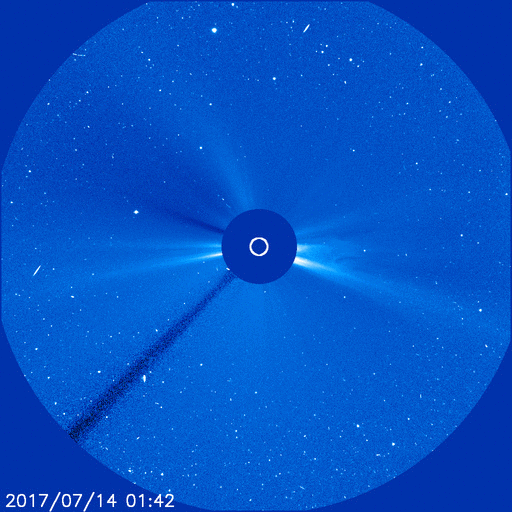1:10 PM | *Biggest sunspot region of the year erupts and Earth's atmosphere could be impacted by Sunday*
Paul Dorian
Ultraviolet telescopes aboard NASA's Solar Dynamics Observatory capture today's coronal mass ejection; courtesy spaceweather.com, NASA/SDO
Overview
The sun has generally been quiet in recent days as it heads rapidly towards the next solar minimum. In fact, there have already been 44 spotless days this year which makes up 23% of the time and this easily surpasses the 32 days experienced in 2016. The current solar cycle (#24) has turned out to be historically weak with the lowest number of sunspots since cycle 14 peaked more than a century ago in 1906. However, even during weak cycles and overall quiet periods on the sun, there can be sporadic large sunspot regions and strong solar storms. Indeed, there is now a very large sunspot region on the sun – the largest of the year – and it has erupted today generating a coronal mass ejection that could impact the Earth’s atmosphere by Sunday.
Daily observations of the number of sunspots since 1 January 1900 according to Solar Influences Data Analysis Center (SIDC). The thin blue line indicates the daily sunspot number, while the dark blue line indicates the running annual average. The recent low sunspot activity of solar cycle 24 continues a recent trend of weakening cycles with the current position in the circled region at the lower, right. Data source: WDC-SILSO, Royal Observatory of Belgium, Brussels. Last day shown: 30 June 2017. Graph courtesy climate4you.com.
AR2665
There were two days last week that featured a completely spotless sun, but then a new sunspot region started to emerge on July 6th over the sun’s eastern limb and it grew quite rapidly as it rotated into fuller view. In fact, the sunspot region known officially as AR2665 doubled in size in the subsequent 24 hours and then reached behemoth levels by July 9th – almost as wide as Jupiter stretching more than 125,000 km from end-to-end.
Prediction by NOAA's Space Prediction Center of most likely region to experience northern lights later this weekend as a result of today's coronal mass ejection; courtesy NOAA/SPC
After days of quiet, this large sunspot region erupted earlier today producing a long-lasting solar flare. Using ultraviolet telescopes, NASA’s Solar Dynamics Observatory captured the explosion which lasted for than two hours according to spaceweather.com. The eruption resulted in a coronal mass ejection (CME) which appears to be headed towards the Earth. This CME is likely to reach the Earth’s upper atmosphere by Sunday, July 16th, possibly resulting in moderate-to-strong geomagnetic storms and high-latitude auroras on Sunday and Monday - including in areas across the northern US.
Meteorologist Paul Dorian
Vencore, Inc.
vencoreweather.com



